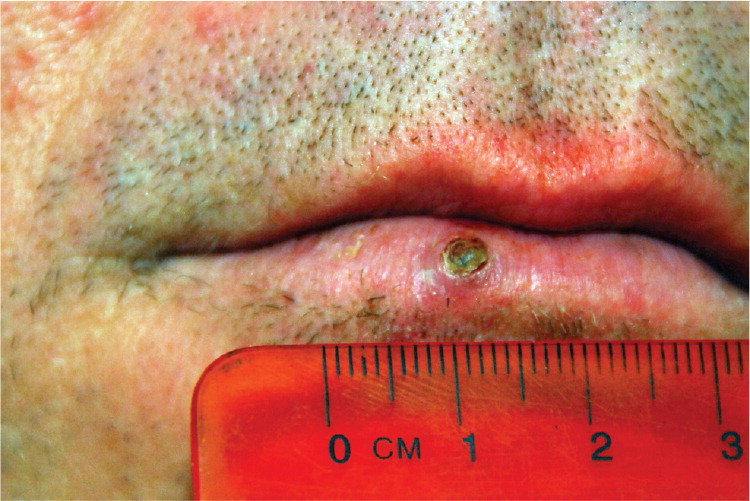
Am Fam Physician. 2011;83(5):601-602
Related letter: Histologic, Microbial Testing to Confirm Dermatologic Conditions.
Author disclosure: Nothing to disclose.
A 46-year-old serviceman deployed to Iraq presented with a papule on his lower lip that had developed over four weeks. Two days after the patient nicked his lip with a razor, a small, red, tender bump appeared. Over the next few weeks, the bump became firmer and slowly enlarged.
Although the patient had received multiple insect bites in the previous weeks, he did not recall any on his lips. He had no fever or chills. He had used smokeless tobacco for 20 years and had moderate sun exposure as a child and adult. Physical examination revealed an indurated, 4-mm papule with a dry central ulcer (see accompanying figure). There was no regional lymphadenopathy, and the patient was otherwise healthy.

Question
Discussion
The answer is C: ecthyma. Ecthyma is a cutaneous bacterial infection that extends into the dermis. It usually occurs on disrupted skin,1 beginning as a vesicle or vesicopustule, then developing a hemorrhagic crust.2 Ecthyma is classically associated with group A streptococci, but staphylococci may also be present. Because the infection extends into the dermis, scarring may result. Ecthyma is treated using systemic antibiotics with good gram-positive coverage.3
Arthropod envenomation from several types of stinging insects can quickly cause large, painful ulcers that are surrounded by erythema. Central eschar may develop. However, it is unlikely that a sting on the patient's lip would go unnoticed. Insect bites and stings with or without envenomation can also serve as portals for infection, including ecthyma.4
Leishmaniasis is caused by intracellular parasites that gain entry during an arthropod bite. The disease can manifest as primary local lesions, delayed mucocutaneous lesions, or visceral leishmaniasis. The classic description of leishmaniasis is a nonhealing ulcer with a rolled border. Because of this patient's travel history, leishmaniasis must be carefully considered,5 especially if there is no response to initial therapy.
Ecthyma gangrenosum is a pseudomonal infection leading to a papule with hemorrhagic crust similar to ecthyma. It results from hematogenous spread of Pseudomonas, which is not suggested by the patient's history or examination. Ecthyma gangrenosum usually occurs in persons who are immunosuppressed or gravely ill.3 When ecthyma gangrenosum is suspected, biopsy with deep tissue Gram stain and culture can be used for diagnosis.
Squamous cell carcinoma often occurs on sun-exposed skin. It presents as a slowly progressive, scaly papule. The quick progression of the patient's lesion and the history of trauma to his lip are more consistent with an infectious process than squamous cell carcinoma.
| Condition | Characteristics |
|---|---|
| Arthropod envenomation necrosis | Large, painful, rapidly developing ulcers surrounded by erythema; may develop central eschar |
| Cutaneous leishmaniasis | A polymorphic eruption, but classically described as a nonhealing ulcer with a rolled border at the site of an arthropod bite |
| Ecthyma | Begins as a vesicle or vesicopustule, then develops hemorrhagic crust |
| Ecthyma gangrenosum | Papule with hemorrhagic crust resembling ecthyma; deep tissue Gram stain and culture can confirm diagnosis, if needed |
| Squamous cell carcinoma | Slowly progressive, scaly papule on sun-exposed areas of skin |
